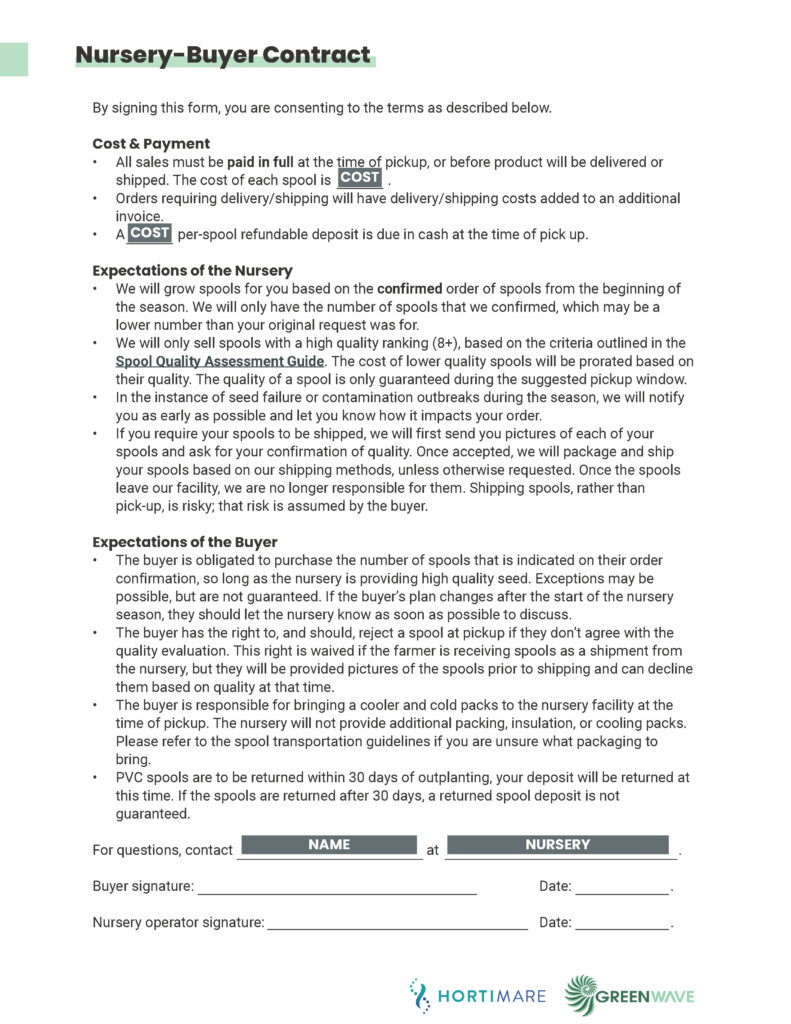Check in with farmers at the end of the harvest season to see how your seed performed
Back to: Propagating Seedstring from Gametophytes
Put a system in place to track seed orders for both gametophytes and seed spools before your nursery season starts. This system can be as simple as a paper log that you update as people inquire. As you are gearing up for your season, reach out to anyone on your list interested in buying seed from your nursery to tally a more exact number. Often, a farmer may not know their exact plan for farm size or the number of lines they would like to plant until they are also getting ready for their season. GreenWave uses an August 31 cutoff for seed orders. Make sure your deadline gives you enough time to make adjustments to your system setup if needed. It is also helpful to set reasonable limits for your nursery prior to committing to seed spool orders.
Following these steps will help you plan your nursery seasons and keep an open line of communication between you, the seed supplier, and the farmers you supply to:
-
-
In mid-summer, contact farmers to remind them of important dates, like the seed order cutoff date, and notify them of any changes to your operations that you will be making in the upcoming season.
-
One week before your order cutoff, remind farmers that orders are due soon.
-
Within a few days of your order cutoff, total up the orders and compare them to your predetermined nursery capacity and seed availability. If you cannot commit to getting every farmer all of the spools or gametophytes they would like, let them know as soon as possible so they can put in an additional order from another nursery.
-
Confirm the orders with the farmers and notify them of the expected timeframe that they will be able to pick up their seed. Inform the farmer of the conditions for ordering that they are agreeing to and have them sign the contract. We’ve included an example of GreenWave’s spool ordering contract below.
-
Once your season is underway and your spools are almost ready for distribution, remind farmers of the pickup timeframe. GreenWave typically sends this reminder two weeks before the spools will be ready and provides a timeframe of two weeks for pickup. Include an update on spool quality in the email.
-
As the seed spool pickup timeframe nears, coordinate pickup times with farmers. Let them know what materials to bring and how to best handle the seed after they take them from your facility. After the seed leaves your facility, it is the farmer’s responsibility.
-
Soon after the seed spool pick up window is over, remind farmers to return their empty spools. It is important to get your spools back to save you the time it takes to make new spools, as well as to prevent excess nursery waste. Consider collecting a spool deposit from farmers that is returned to them when they return their empty spools as an incentive to return spools in a timely manner.
-
Keep in touch with your farmers during the season to gauge the success of your seed.
Move the dial clockwise to see a visualization of when and what to communicate to farmers ordering your seed. (You can drag the dial or use your arrows on your keyboard.)
Seed Spool Orders
It is important for you as a seller to set and communicate reasonable expectations to your buyers. One way to do this is through a contract. The contract does not need to be long or complicated, but it does need to clearly outline what both the nursery and farmer can expect from each other and where the nursery’s responsibility ends and the buyer’s responsibility begins. Send this contract to the farmers when you confirm their spool order. The contract should include points on pricing, timing, seed quality, a chain of custody of spools (i.e. who is responsible for the spools at what points), and what happens if your seed does not meet the farmer’s standards. We’ve included a sample contract below. Use this as a guide to draft your own contract that reflects the terms and best practices of your nursery operation.

Having a contract helps both parties align expectations. A farmer should refuse spools that do not meet quality standards, and a nursery should inform farmers before pickup if this might be the case. Determining the quality of a spool can be difficult because there are many factors at play such as total coverage, health/color of the sporophytes, size of the sporophytes, and presence of contamination. You can use the Seed Spool Quality Grading Guidelines chart, along with the Contamination Identification for Spools chart to help you understand why each of the factors is important and determine the overall quality of spools.
Gametophyte Seed Orders
Biomass that is being shipped for seeding should be prepped before it is sent unless otherwise discussed with the buyer. This means grinding, weighing, and separating out the biomass. We talk more about these steps in the Nursery Operations section of this course. Use the guidelines in the Gametophyte Maintenance section to help you determine the health and quality of gametophyte biomass before preparing it for seeding. Ship biomass according to the protocol discussed in the Shipping Gametophyte Biomass section. Make sure the recipient is familiar with the Protocol for Painting Biomass onto Spools and has the necessary equipment before shipping their biomass. Determining the cost of gametophyte biomass is up to you, but be sure to incorporate the costs of year-round care for the gametophyte cultures.